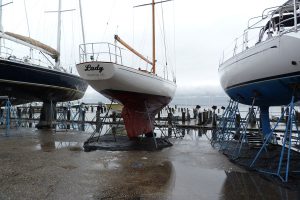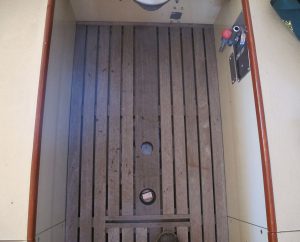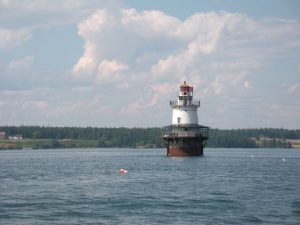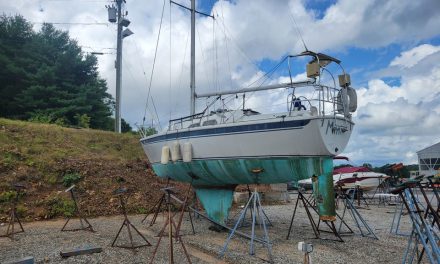LOVE MY TILLER, LOVE MY WHEEL
Granted some boats are too small for a pedestal, but I don’t think many are too large for a tiller. So last month I put it to you: If you’ve got wheel steering do you long for a tiller? Are you with a tiller wishing for a wheel? Reader Allen LeBlanc is very happy with the tiller on his Tanzer 26 and reader Joseph Pitoniak appreciates the benefits a tiller offers, but is happy for the wheel on his Pearson 31 as it eases the steering workload and doesn’t aggravate his sciatica. Reader and Good Old Boat contributor Jim Shell says he’s in the I-don’t-care category. I didn’t hear from anyone with a tiller wishing for a wheel — though I know they’re out there, plenty of boats in the 28- to 30-foot range get converted all the time. –MR
We race a Santana 22 and love the tiller for its direct connection to the sea. Friends who own bigger, wheel-steered boats [sail with us and] never fail to express their delight with its responsiveness. I’ve also done some longer deliveries on the ocean with and without autopilot. The wheel on a larger boat is just easier to make a passage with. When things get rough, the fatigue factor is much lower with the wheel. I can’t imagine minding a tiller closely for a couple of weeks or so.
–Stefan Berlinski, Hamachi
For fifteen years my boat was a Shannon 28 cutter with a tiller. I loved the tiller for the reasons you cite. Then, 5 years ago, I decided to upgrade to a Shannon 38 cutter with a wheel. I mightily miss that tiller. If I could exchange my wheel for a tiller without spending a ton of money, I would gladly do so. But even if I had the money, the stern configuration would place a tiller too far forward in the cockpit for my taste. The stern configuration on my 28-footer had the rudder hung off the transom on gudgeons. This position enabled me to steer the boat from the aft end of the cockpit, a position that works better for me than the forward part of the cockpit where visibility forward would be compromised.
I guess this is a classic example of the old saying that in boating we almost always have to give up something we like to get something we want. Overall, I’m very happy with my 38-footer. The bigger boat is more stable and comfortable in a seaway, more roomy below decks, and faster by a knot or more in most conditions. Perhaps most importantly, my wife likes the bigger boat better. Consequently, we go out more often, even if the wind and waves are up. But I still miss the tiller.
–Neale Sweet, Camden, Maine
 Michael, like you my first keel boat was a 27-footer (C&C) with a tiller. When looking at “moving on up” I never expected to find a bigger boat without giving up tiller steering. But in 2003 my wife and I stumbled across our current good old boat. It’s a Cal 43! And it has a long, sturdy tiller. It steers like a dream and keeps us under the dodger/bimini enclosure while at the helm. No standing out at the wheel in the weather while transiting up and down the Washington Coast and Strait of Juan de Fuca on our way to and from our summer cruising grounds in the Salish Sea.
Michael, like you my first keel boat was a 27-footer (C&C) with a tiller. When looking at “moving on up” I never expected to find a bigger boat without giving up tiller steering. But in 2003 my wife and I stumbled across our current good old boat. It’s a Cal 43! And it has a long, sturdy tiller. It steers like a dream and keeps us under the dodger/bimini enclosure while at the helm. No standing out at the wheel in the weather while transiting up and down the Washington Coast and Strait of Juan de Fuca on our way to and from our summer cruising grounds in the Salish Sea.
Thanks to the tiller, our auto pilot is a tiller pilot and the boat also has wind-vane steering. When parking and maneuvering with the tiller, the boat can turn on a dime. At anchor, the cockpit is roomy and comfortable with the tiller extended upright.
Jensen Marine built 14 Cal 43s designed by Bill Lapworth. We have hull #6, built in 1970. I will never trade the responsiveness of my tiller for a new boat with a wheel.
–Alan & Rhonda Boguslawski, Vancouver, British Columbia
The boat I learned to sail on 6 years ago, a beat-down 1962 New Horizons 26, had a tiller. As a newbie, I was determined that my next boat would have a wheel — like a “real” sailboat. A wheel was one of the main features I looked for when I was scrolling through ads for my next boat. I found that perfect boat: a 1979 Dufour 31. With a tiller. Now, 4 1/2 years, and thousands of nautical miles later, that Dufour is soon to be for sale, and I am sad to think that unfortunately, my next boat will likely have a wheel. I will miss that responsive connection to the helm, that gave instant feedback, that I could feel the power an
d vibrations surging through in heavy wind. The ability to single hand, working both headsail winches while steering through tacks with my knees. And, I will miss that wide-open cockpit at anchor, plenty of room for everyone.
–Jamie Chase, Kamloops, BC
 I have tiller steering on Marquesa II (a 1966 HR 28 I sail out of Clayton, New York), and converted Lady (a 1947 Owens Cutter I sail out of Annapolis, Maryland) from tiller to wheel steering. I’m thinking about converting Lady back to tiller steering. I like it better than wheel, primarily because of feedback and comfort (or perhaps just being used to tiller steering throughout my sailing career). Tillers do take up less space in port, but they require
I have tiller steering on Marquesa II (a 1966 HR 28 I sail out of Clayton, New York), and converted Lady (a 1947 Owens Cutter I sail out of Annapolis, Maryland) from tiller to wheel steering. I’m thinking about converting Lady back to tiller steering. I like it better than wheel, primarily because of feedback and comfort (or perhaps just being used to tiller steering throughout my sailing career). Tillers do take up less space in port, but they require
more when sailing, so that’s a trade.
–Mark Fontaine
A SECOND VOTE FOR IPE
 I just picked up the November issue of Good Old Boat at my local newsagent (it’s 45 miles from here) and read the letter and response regarding ipe (“When Christmas came to Christmas,” September 2017). Petrel‘s ipe cockpit grating is six years old and in fine shape with longitudinal slats and transverse members underneath screwed up into the slats, no glue and no cutouts. The wider centerline slat has holes for the fuel tank and for viewing the gauge, plus a lift out for the aft section. I originally designed it for ¾-inch teak, but reduced the thickness to 11/16-inch after bending some sample slats. Today I would reduce the ipe to 5/8-inch. If I was to glue ipe, I’d experiment with WEST System G-Flex epoxy. Here’s a note from the WEST System guide: “G/Flex adheres tenaciously to difficult-to-glue hardwoods, both tropical and domestic varieties– white oak, ipe, teak, greenheart, purpleheart and black walnut to name a few.”
I just picked up the November issue of Good Old Boat at my local newsagent (it’s 45 miles from here) and read the letter and response regarding ipe (“When Christmas came to Christmas,” September 2017). Petrel‘s ipe cockpit grating is six years old and in fine shape with longitudinal slats and transverse members underneath screwed up into the slats, no glue and no cutouts. The wider centerline slat has holes for the fuel tank and for viewing the gauge, plus a lift out for the aft section. I originally designed it for ¾-inch teak, but reduced the thickness to 11/16-inch after bending some sample slats. Today I would reduce the ipe to 5/8-inch. If I was to glue ipe, I’d experiment with WEST System G-Flex epoxy. Here’s a note from the WEST System guide: “G/Flex adheres tenaciously to difficult-to-glue hardwoods, both tropical and domestic varieties– white oak, ipe, teak, greenheart, purpleheart and black walnut to name a few.”
The attached photograph is a quick-and-dirty shot of the forward panel. Note that having only longitudinal gaps works better when heeled than traditional grating.
–Jay Paris, West Bath, Maine





